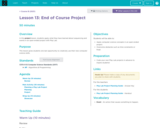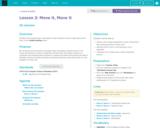
Use binary code to make a bracelet.
- Subject:
- Computer Science
- Material Type:
- Activity/Lab
- Lesson
- Student Guide
- Provider:
- Idaho National Lab
- Provider Set:
- Learning from Home
- Author:
- Idaho National Lab
- Date Added:
- 11/08/2024

Use binary code to make a bracelet.

Students recall how their data is collected then think through how they would use that data as software engineers. They read case studies on privacy and security breaches and debate about the tradeoffs between the utility of data collection and safeguarding privacy and security.
This lesson is aligned to CSTA standards.

Students continue to develop their Creative Coding Project to create a program that portrays a personal interest or solves a problem using the console. Students first self-assess their work to evaluate their progress in completing project requirements, then continue developing their projects. Students then conduct acceptance testing to determine which of their user stories are complete and use the self-assessment and peer feedback to prioritize their remaining tasks.
This lesson is aligned to CSTA standards.

In the previous lesson, students conducted self-assessments and wrote acceptance criteria for their projects. Students obtain peer feedback in this lesson to identify remaining tasks to complete and continue developing their Creative Coding with the Console Project.
This lesson is aligned to CSTA standards.

Students conducted code reviews at the end of the previous lesson to give and receive feedback that assists in identifying areas of improvement and fixes for problems they encountered. At this stage of the project, students consider this feedback as they finalize development in this lesson. Students share their final projects with their peers to celebrate their successes.
This lesson is aligned to CSTA standards.

Students practice developing solutions to AP CSA FRQs on a mock 2D Arrays FRQ. Students apply decomposition and annotation strategies to identify the key components of the problem and validate their solutions using Scoring Guidelines.
This lesson is aligned to CSTA standards.

Students are introduced to the Creative Coding with the Console Project and evaluate requirements and examples to identify questions and key features. Students learn about project backlogs and benchmarks and set up their Project Planning Board by identifying some of the tasks they need to complete for the project.
This lesson is aligned to CSTA standards.

Students have used searching in standard algorithms to find a target element in a list. In this lesson, students explore the linear search algorithm and how it can be applied to different data structures. Students learn how to use execution counts to determine the best, average, and worst cases and practice evaluating algorithms for their efficiency. Students then write user stories for their projects to identify required program features.
This lesson is aligned to CSTA standards.

Students discover a better searching algorithm that can perform more efficiently if the list is already sorted. Students trace code for a binary search to evaluate its efficiency and compare it to the linear search. Students apply the binary search algorithm to solve problems in a variety of scenarios. Students then begin their initial plans for their Creative Coding with the Console Project.
This lesson is aligned to CSTA standards.

Students revisit recursion and explore how the binary search algorithm can be implemented recursively. Students then practice implementing the binary search algorithm iteratively or recursively before finalizing their planning for their Creative Coding with the Console Project and participating in a peer review to receive feedback on their work.
This lesson is aligned to CSTA standards.

Students explore the selection sort algorithm and practice tracing the algorithm to evaluate its efficiency. Students identify the benefits and limitations of the selection sort algorithm, then practice implementing it in Java to sort elements.
This lesson is aligned to CSTA standards.

Students explore the insertion sort algorithm and compare its functionality and efficiency with the selection sort algorithm. Students analyze the efficiency of each algorithm using execution counts and identify the benefits and limitations of the selection and insertion sort algorithms.
This lesson is aligned to CSTA standards.

Students explore the merge sort algorithm to organize elements in a list using a divide-and-conquer approach. Students identify the components of the algorithm and learn about helper functions. Students then trace the algorithm to understand its functionality and determine its efficiency using execution counts. Students then work through the tasks on their Project Planning Board to begin the development of their Creative Coding with the Console Project.
This lesson is aligned to CSTA standards.

Students explore traversing multiple lists at the same time by creating algorithms and tracing code involving multiple lists. Students identify scenarios where multiple lists might be needed and consider how multiple lists might be used and traversed in games. Students then continue working through the tasks on their Project Planning Board to develop their Creative Coding with the Console Project.
This lesson is aligned to CSTA standards.

Students have explored searching and sorting algorithms, analyzed their efficiencies using execution counts, and implemented algorithms to work with multiple lists. Students plan and implement solutions using searching and sorting algorithms to solve problems involving one or more lists. Students then participate in a peer review to give and receive feedback on the progress they have made on their Creative Coding with the Console Project.
This lesson is aligned to CSTA standards.

In this context-setting lesson, the class will experience the concept of events through a game where they move or shout when you press buttons on a giant remote. This lesson aligns to national Computer Science standards from CSTA.

In this mini-project, students will have the opportunity to learn how to use events in Play Lab and apply all of the coding skills that they've learned to create an animated game. This lesson aligns to national Computer Science standards from CSTA.

In this project lesson, students apply what they have learned about sequencing and events in an open-ended project with Play Lab. This lesson aligns to national Computer Science standards from CSTA.

Students will program their classmates to step carefully around a large grid on the floor in this context-setting lesson. This lesson aligns to national Computer Science standards from CSTA.

In this skill-building lesson, students will develop sequential algorithms to move a bird from one side of a maze to the pig at the other side. To do this they will stack code blocks together in a linear sequence. This lesson aligns to national Computer Science standards from CSTA.